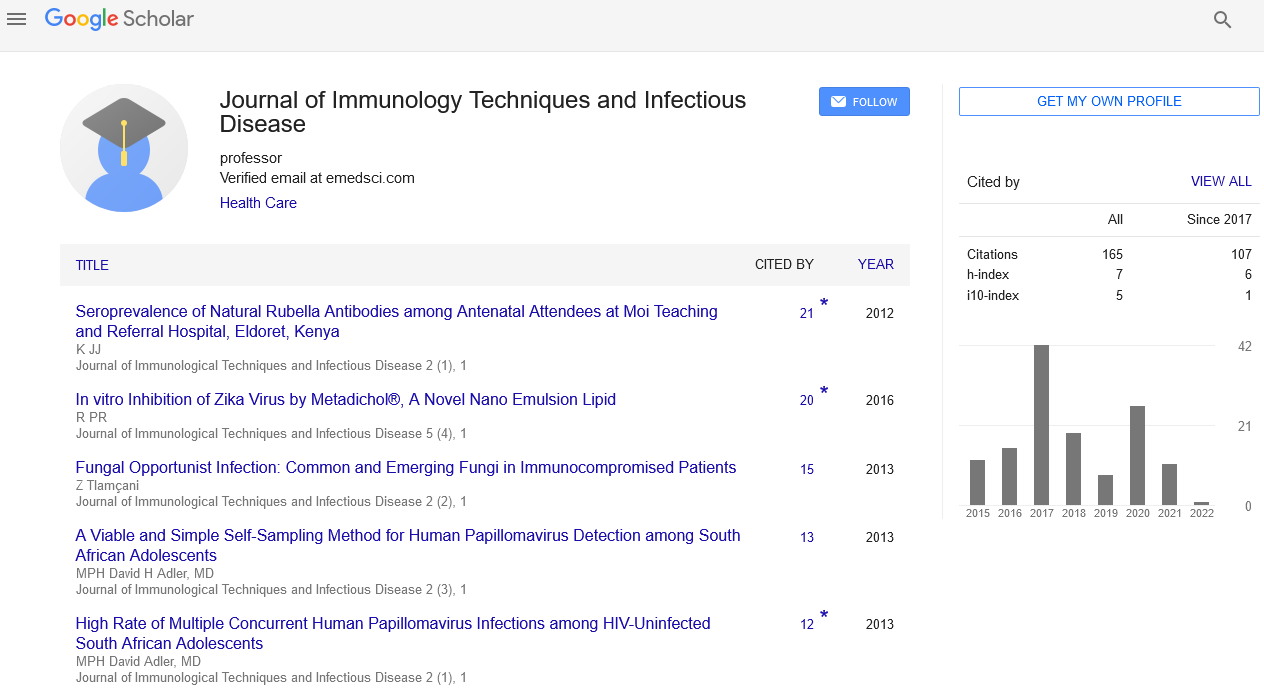Perspective, J Immunol Tech Infect Dis Vol: 12 Issue: 2
Clinical Manifestations and Treatment for Babesiosis and Its Impact on Health
Javis Tunio*
1Department of Veterinary Parasitology, Sindh Agriculture University, Tandojam, Pakistan
*Corresponding Author: Javis Tunio,
Department of Veterinary Parasitology,
Sindh Agriculture University, Tandojam, Pakistan
E-mail: Javistu.nio@gmail.com
Received date: 29 May, 2023, Manuscript No. JIDIT-23-105426;
Editor assigned date: 31 May, 2023, PreQC No. JIDIT-23-105426 (PQ);
Reviewed date: 14 June, 2023, QC No. JIDIT-23-105426;
Revised date: 21 June, 2023, Manuscript No. JIDIT-23-105426 (R);
Published date: 28 June, 2023, DOI: 10.4172/2329-9541.1000341.
Citation: Tunio J (2023) Clinical Manifestations and Treatment for Babesiosis and Its Impact on Health. J Immunol Tech Infect Dis 12:2.
Description
Babesiosis is a tick-borne infectious disease caused by protozoan parasites of the genus Babesia. It primarily affects mammals, including humans, and is transmitted through the bite of infected ticks. The disease has gained significant attention in recent years due to its increasing incidence and expanding geographical range. This provides a comprehensive overview of babesiosis, including its etiology, transmission, clinical manifestations, diagnosis, treatment, and prevention strategies. Furthermore, the challenges associated with babesiosis management and highlight the importance of public health interventions to mitigate its impact.
Babesiosis is a tick-borne infectious disease caused by protozoan parasites of the genus Babesia. It was first identified in cattle in the late 19th century and was subsequently recognized as a zoonotic disease capable of infecting humans. The disease is primarily endemic in certain regions of the United States, Europe, and parts of Asia, although its incidence has been steadily increasing in recent years. This aims to provide a comprehensive overview of babesiosis, covering various aspects of the disease, including its etiology, transmission, clinical manifestations, diagnosis, treatment, and prevention.
Etiology and transmission
Babesiosis is caused by various species of Babesia parasites, with Babesia microti being the most common species associated with human infections in the United States. These parasites are obligate intracellular organisms that invade red blood cells, leading to hemolysis and subsequent clinical manifestations. Ticks, particularly Ixodes scapularis in North America and Ixodes ricinus in Europe, serve as the primary vectors for transmitting the disease to humans. In rare cases, babesiosis can also be transmitted through blood transfusions or congenitally from an infected mother to her child.
Clinical manifestations
The clinical presentation of babesiosis can range from asymptomatic or mild flu like symptoms to severe and life-threatening manifestations particularly in immunocompromised individuals or those with coexisting medical conditions. Common symptoms include fever, chills, fatigue, headache, muscle aches, and sweats. Severe cases may exhibit complications such as hemolytic anemia, renal failure, or disseminated intravascular coagulation. Co-infection with other tickborne pathogens, such as Lyme disease or Anaplasma, is also possible and can complicate the clinical picture.
Diagnosis and laboratory testing
Accurate and timely diagnosis of babesiosis is important for appropriate management. Microscopic examination of Giemsa-stained blood smears remains the gold standard for identifying Babesia parasites within red blood cells. However, due to the low parasitemia in some cases and the potential for human error in interpretation, molecular diagnostic methods such as Polymerase Chain Reaction (PCR) assays have gained prominence. Serological testing, although less sensitive and specific can provide supportive evidence of past or current infection.
Treatment and management
The treatment of babesiosis primarily involves the administration of antiprotozoal medications, such as atovaquone plus azithromycin or clindamycin plus quinine, for a specified duration. Patients with severe disease or immunocompromised individuals may require hospitalization and additional supportive measures. Prompt treatment initiation is important to prevent complications and reduce the risk of fatality. Management of co-infections, if present, should be considered concurrently.
Preventing babesiosis relies on several strategies, including personal protective measures to avoid tick bites, such as wearing protective clothing and using insect repellents. Conducting tick checks after potential exposure and promptly removing attached ticks can also help reduce the risk of infection. Tick control measures, such as habitat modification, acaricides, and the use of tick-repellent products on pets, can contribute to reducing tick populations in endemic areas. Public health initiatives should focus on raising awareness about babesiosis, educating healthcare professionals, and implementing surveillance systems to monitor the disease's prevalence and distribution.
Babesiosis is an emerging tick-borne disease with increasing global significance. It poses a significant threat to human health, particularly in endemic regions. Improved understanding of the disease's etiology, transmission, clinical manifestations, and diagnostic techniques is essential for accurate diagnosis and effective management. Timely treatment initiation and implementation of preventive measures can help mitigate the impact of babesiosis on individuals and communities. Further study is needed to develop more sensitive diagnostic tools, evaluate new treatment options, and enhance public health interventions to control and prevent babesiosis effectively.
 Spanish
Spanish  Chinese
Chinese  Russian
Russian  German
German  French
French  Japanese
Japanese  Portuguese
Portuguese  Hindi
Hindi 
